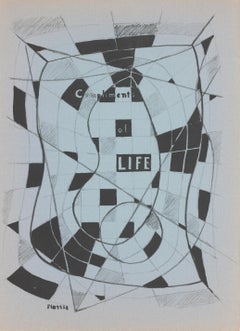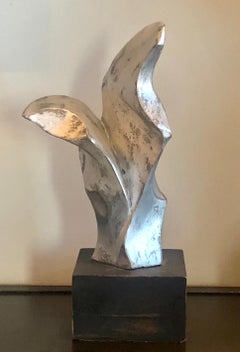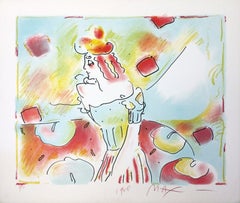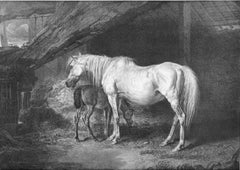George L.K. Morris Art
to
2
1
Overall Width
to
Overall Height
to
3
1
1
1
2
2
1
1
1
1
1
1
4
9,082
2,693
2,504
1,351
1
3
Artist: George L.K. Morris
original lithograph
By George L.K. Morris
Located in Henderson, NV
Medium: original lithograph. This lithograph is from the rare 1951 "Improvisations" portfolio, published by the Artists Equity Association of New York on the occasion of the 1951 Spr...
Category
1950s George L.K. Morris Art
Materials
Lithograph
Abstract Sculpture Mid 20th Century Modern Non Objective Biomorphic Plaster WPA
By George L.K. Morris
Located in New York, NY
Modern artist George L.K. Morris created this abstract biomorphic nonobjective plaster sculpture during the WPA era of the 1930s / 40s. Monogrammed.
Though George Lovett Kingsland Morris studied with realist painters John Sloan and Kenneth Hayes Miller at the Art Students League, the influence of their points of view was replaced by that of abstractionists Amedee Ozenfant and Fernand Leger. The paintings of Morris were two-dimensional, hard-edged and brightly colored.
Born in New York City in 1905, Morris became a full-fledged abstractionist and a founder in 1936 of the American Abstract Artists. He edited "The World of Abstract Art, the group's publication, and was their president from 1948-1950.
Morris had graduated from Yale in 1928 and studied at the League until 1930, when he went to Paris to attend the Academie Moderne. A sculptor, writer, art critic and teacher in addition to abstract painter Morris himself later taught at the Art Students League from 1943-1944, as well as St. John's College, Annapolis, Maryland, 1960-1961.
Morris' intrinsic abstract bent was made even clearer by his positive feeling for Hans Arp's sculpture. He and Arp edited the French art magazine, "Plastique." Morris also edited the "Bulletin of the Museum of Modern Art" and "Partisan Review."
He died in 1975 in New York City.
George LK...
Category
1930s American Modern George L.K. Morris Art
Materials
Plaster
Untitled [Abstraction]
By George L.K. Morris
Located in New York, NY
Gouache on paper, 18 7/8 x 14 3/4 in.
Signed (at lower right): Morris; (with monogram, on the back): GLKM [monogram] / 1932 [sic]
Executed circa late 1940s
A passionate advocate of abstract art during the 1930s and 1940s, George L. K. Morris was active as a painter, sculptor, editor, and critic. An erudite man with an internationalist point of view, Morris
eschewed the social, political, and figural concerns that preoccupied so many artists of Depression-era America, believing that painters should focus their attention on the beauty, refinement, and simplicity of pure form instead. His goal, he said, was “to wedge the expression further and further into the confines of the canvas until every shape takes on a spatial meaning” (as quoted in Ward Jackson, “George L. K. Morris: Forty Years of Abstract Art,” Art Journal 32 [Winter 1972–73], p. 150).
Born into an affluent family in New York City, Morris was a descendent of General Lewis Morris, a
signer of the Declaration of Independence. From 1918 until 1924, he attended the Groton School in
Connecticut, studying classics and art. He continued to focus on literature and art while attending
Yale University (1924–28), an experience that prepared him well for his future activity as an artist-critic. After graduating in 1928, Morris studied at the Art Students League of New York, working
under the realist painters John Sloan and Kenneth Hayes Miller, as well as Jan Matulka, the only
modernist on the faculty. In the spring of 1929, Morris traveled to Paris with Albert E. Gallatin, a
family friend and fellow painter who introduced him to leading members of the Parisian avant-garde, including Jean Arp, Pablo Picasso, Georges Braque, Jean Hélion, and Piet Mondrian. Morris also took classes at the Académie Moderne, studying under Fernand Léger and Amédée Ozenfant, important exponents of Synthetic Cubism who influenced his aesthetic development. Indeed, after experimenting with the simplified forms of Modernism for a few years, Morris moved on to abstraction by 1934, adopting a hard-edged, geometric approach inspired by Leger’s cubist style and the biomorphic shapes of Arp and Joan Miró.
Following his return to New York in 1930, Morris built a white-walled, open-spaced studio (inspired
by that of Ozenfant, which had been designed by Le Corbusier) on the grounds of Brockhurst, his
parents’ 46-acre estate in Lenox, Massachusetts. In 1935, he married the painter and collagist Estelle “Suzy...
Category
1940s American Modern George L.K. Morris Art
Materials
Paper, Gouache
Related Items
COMPOSITION RED AND GREEN
By Peter Max
Located in Aventura, FL
Hand signed, dated and numbered by the artist. Artwork is in excellent condition. Certificate of Authenticity included. PP edition. All reasonable offers will be considered.
Category
1980s Pop Art George L.K. Morris Art
Materials
Paper, Lithograph
Primrose and Foal: A Brood-Mare, late the Property of his Grace the Duke of Graf
By James Ward
Located in Boston, MA
From Celebrated Horses, Grundy 24. A fine chine applique impression in fine condition with full margins. A proof before letters. Exhibited at the...
Category
19th Century Romantic George L.K. Morris Art
Materials
Lithograph
$3,500
H 13.25 in W 17.75 in
Joan Miro (Plate 4)
By Joan Miró
Located in Washington, DC
Artist: Joan Miro
Title: Joan Miro (Plate 4)
Portfolio: Joan Miro
Medium: Original lithograph
Year: 1956
Edition: Unnumbered
Frame Size: 15 1/2" x 14 1/4"
Sheet Size: 9" x 7 1/2"
Sig...
Category
1950s Abstract George L.K. Morris Art
Materials
Lithograph
La Pique (I), from A Los Toros Avec Picasso
By Pablo Picasso
Located in Washington, DC
Artist: Pablo Picasso
Title: La Pique (I)
Portfolio: A Los Toros Avec Picasso
Medium: Transfer lithograph
Date: 1961
Frame Size: 17 1/4" x 19 3/4"
Sheet Size: 9 1/2" x 12 1/2"
Image ...
Category
1960s Abstract George L.K. Morris Art
Materials
Lithograph
"Somber Planet"
By Manfred Schwartz
Located in Astoria, NY
Manfred Schwartz (American, b. Poland, 1909-1970), "Somber Planet", Lithograph on Paper, mid 20th century, numbered edition "13/90" lower left, signed in pencil lower right, with the...
Category
Mid-20th Century Modern George L.K. Morris Art
Materials
Paper, Lithograph
Unknown Title, limited ed, lithograph by abstract expressionist Paul Jenkins
By Paul Jenkins
Located in Chesterfield, MI
Paul Jenkins' works are described as: "Flowing veils of color that overlap and interact together, seeping and bleeding vivid color." In 1954 Jenkins had his first exhibition in Paris...
Category
1970s Abstract Expressionist George L.K. Morris Art
Materials
Lithograph
$720 Sale Price
20% Off
H 29 in W 24 in
Asbury Park II
By Michael Rubin
Located in San Francisco, CA
This artwork titled "Asbury Park II" 1992 is an original color lithograph on Wove paper by noted American abstract expressionist artist, Michael Rubin, bor...
Category
Late 20th Century Abstract Expressionist George L.K. Morris Art
Materials
Lithograph
R.E.M. - Murmur (Grammy, Album Art, Iconic, Rock and Roll, Pop, Legendary)
By Kerry Smith
Located in Kansas City, MO
Kerry Smith
R.E.M. - Murmur
Mixed Media on Crescent board
Year: 2022
Size: 21x20in
Signed, dated by hand
COA provided
Ref.: 924802-1633
*Black frame with a mirror-gloss finish avail...
Category
2010s American Modern George L.K. Morris Art
Materials
Mixed Media, Acrylic, Gouache, Board
$888 Sale Price
25% Off
H 21 in W 22 in D 1 in
Jack Levine American Modernist Social Realist WPA Artist Lithograph Dinner Party
By Jack Levine
Located in Surfside, FL
This is being sold unframed. Reception in Miami.
Born to Lithuanian Jewish parents, Levine grew up in the South End of Boston, where he observed a street life composed of European immigrants and a prevalence of poverty and societal ills, subjects which would inform his work. He first studied drawing with Harold K. Zimmerman from 1924-1931. At Harvard University from 1929 to 1933, Levine and classmate Hyman Bloom studied with Denman Ross. As an adolescent, Levine was already, by his own account, "a formidable draftsman". In 1932 Ross included Levine's drawings in an exhibition at the Fogg Art Museum at Harvard, and three years later bequeathed twenty drawings by Levine to the museum's collection. Levine's early work was most influenced by Bloom, Chaim Soutine, Georges Rouault, and Oskar Kokoschka. Along with Bloom and Karl Zerbe, he became associated with the style known as Boston Expressionism.
In 1935, shortly after its formation, Levine joined the WPA’s Federal Art Project, where he was employed intermittently until 1939. In 1937, while with the WPA, Levine painted The Feast of Pure Reason...
Category
20th Century Realist George L.K. Morris Art
Materials
Paper, Color, Lithograph
"Women's Hands, Smoking" 2000 Four-Panel Iris Print by Julia Jacquette
By Julia Jacquette
Located in Bristol, CT
Classic four panel iris print 'Women's Hands, Smoking' 2000 from the Holly Solomon Gallery in an edition #2/ of 50 (LL) by Julia Jacquette (pencil signed (LR)
Print Sz: 9" x 9"
Frame Sz: 11 1/2" x 11 1/2"
Julia Jacquette (born 1964) is an American artist primarily based in New York City and Amsterdam. She grew up in the Upper West Side by Columbus Avenue which was where her family's apartment was. Jacquette studied at Skidmore College in Saratoga Springs, NY (1986) and Hunter College in New York City (1989–92).
Jacquette's work has been shown widely at galleries and museums around the world including Holly Solomon Gallery in New York City, David Klein Gallery...
Category
Early 2000s George L.K. Morris Art
Materials
Lithograph
$750
H 11.5 in W 11.5 in
Asger Jorn - Von Kopf bis Fuss 10/75 - 1967
By Asger Jorn
Located in Milano, MI
"From Head to Toe" belongs to the late graphic series that represent the high point of his graphic work. He impressively demonstrates his talent in dealing with colour and impressive...
Category
1960s Abstract George L.K. Morris Art
Materials
Lithograph
Storm Dragon
By Don Ed Hardy
Located in Lyons, CO
Color lithograph, Edition 20.
Don Ed Hardy’s lithographs “Storm Dragon” and “Sea Dragon” continue his lifelong exploration of dragon mythology and imagery. For 2000, the Year of the...
Category
Early 2000s Contemporary George L.K. Morris Art
Materials
Lithograph
George L.k. Morris art for sale on 1stDibs.
Find a wide variety of authentic George L.K. Morris art available for sale on 1stDibs. You can also browse by medium to find art by George L.K. Morris in gouache, lithograph, paint and more. Much of the original work by this artist or collective was created during the 20th century and is mostly associated with the modern style. Not every interior allows for large George L.K. Morris art, so small editions measuring 9 inches across are available. Customers who are interested in this artist might also find the work of Cecil Crosley Bell, August Mosca, and Dudley Vaill Talcott. George L.K. Morris art prices can differ depending upon medium, time period and other attributes. On 1stDibs, the price for these items starts at $100 and tops out at $45,000, while the average work can sell for $25,000.


![george l k morris Untitled [Abstraction]](https://a.1stdibscdn.com/george-lk-morris-1905-1975-american-paintings-untitled-abstraction-for-sale/a_23/1652214284908/APG_8941_unfr_master.jpg?width=240)

